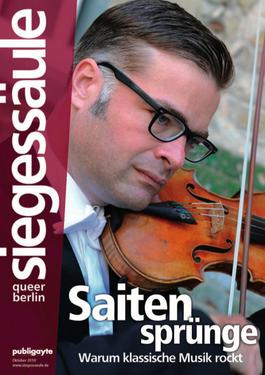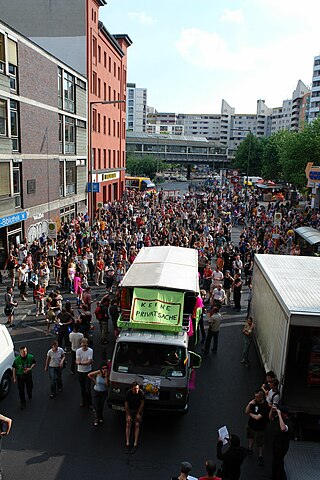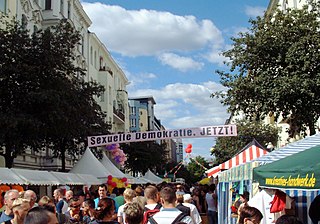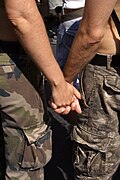
Leather subculture denotes practices and styles of dress organized around sexual activities that involve leather garments, such as leather jackets, vests, boots, chaps, harnesses, or other items. Wearing leather garments is one way that participants in this culture self-consciously distinguish themselves from mainstream sexual cultures. Many participants associate leather culture with BDSM practices and its many subcultures. For some, black leather clothing is an erotic fashion that expresses heightened masculinity or the appropriation of sexual power; love of motorcycles, motorcycle clubs and independence; and/or engagement in sexual kink or leather fetishism.

Christopher Street Day (CSD) is an annual European LGBTQ+ celebration and demonstration held in various cities across Europe for the rights of LGBTQ+ people, and against discrimination and exclusion. It is Germany's and Switzerland's counterpart to Gay Pride or Pride Parades. Austria calls their Pride Parade Rainbow Parade. The most prominent CSD events are Berlin Pride, CSD Hamburg, CSD Cologne, Germany and Zürich in Switzerland.

The leather pride flag is a symbol used by the leather subculture since the 1990s. It was designed by Tony DeBlase, and was quickly embraced by the gay leather community. It has since become associated with the leather community in general and also with other kink and fetish subcultures such as the BDSM community.

Folsom Street Fair (FSF) is an annual BDSM and leather subculture street fair, held in September that concludes San Francisco's "Leather Pride Week". The Folsom Street Fair, sometimes referred to simply as "Folsom", takes place on the last Sunday in September, on Folsom Street between 8th and 13th Streets, in San Francisco's South of Market district.

LGBT tourism is a form of tourism marketed to gay, lesbian, bisexual, and transgender (LGBT) people. People might be open about their sexual orientation and gender identity at times, but less so in areas known for violence against LGBT people.

The Leather Archives & Museum (LA&M) is a community archives, library, and museum located in the Rogers Park neighborhood of Chicago, Illinois. Founded by Chuck Renslow and Tony DeBlase in 1991, its mission is "making leather, kink, BDSM, and fetish accessible through research, preservation, education and community engagement." The LA&M is a leading conservator of queer erotic art. Its permanent collection features some of the most iconic LGBT artists of the twentieth century, including most artwork by Bill Schmeling and many works by Dom Orejudos.

Nollendorfplatz is a square in the central Schöneberg district of Berlin, Germany.

The San Francisco Lesbian, Gay, Bisexual, and Transgender Pride Celebration, usually known as San Francisco Pride, is a pride parade and festival held at the end of June most years in San Francisco, California, to celebrate the lesbian, gay, bisexual, and transgender (LGBT) people and their straight allies.

Siegessäule is Berlin's most widely distributed queer magazine and has been published monthly, except for two brief hiatuses, since April 1984. Originally only available in West Berlin, it ran with the subtitle "Berlin's monthly page for Gays". In 1996, it was broadened to include lesbian content, and in 2005 it was expanded to reach a wider queer target base, becoming the only magazine of its scale in Europe to represent the full spectrum of the LGBT community. The magazine is available for free at around 700 locations in Berlin, printing 53.688 copies per month. Since March-issue 2013, it has been overseen by chief editor Jan Noll.

Folsom Europe, also known as Folsom Straßenfest, is an annual BDSM and leather subculture street fair held in September in Berlin, Germany since 2003.

Berlin is recognized as a world city of culture and creative industries. Numerous cultural institutions, many of which enjoy international reputation are representing the diverse heritage of the city. Many young people, cultural entrepreneurs and international artists continue to settle in the city. Berlin has established itself as a popular nightlife and entertainment center in Europe.

The Berlin Pride Celebration, also known as Christopher Street Day Berlin, or CSD Berlin, is a pride parade and festival held in the second half of July each year in Berlin, Germany to celebrate the lesbian, gay, bisexual, transgender and queer (LGBTQ+) people and their allies. Since 1979, the event has been held each year. Berlin Pride is one of the largest gay and lesbian organized events in Germany and one of the biggest in Europe. Its aim is to demonstrate for equal rights and equal treatment for LGBT people, as well as celebrate the pride in Gay and Lesbian Culture.

The Kreuzberg Pride, usually known as Transgenialer CSD, was a parade and festival held in June each year in Kreuzberg, Berlin, to celebrate the lesbian, gay, bisexual, and transgender (LGBT) people and their allies. From 1998 to 2013, the event had been held each year. In the same month both Berlin Pride and Gay Night at the Zoo is held. More gay festivals in Berlin are the fetish festivals Folsom Europe and Easter in Berlin.

The Edmonton Pride Festival is a 2SLGBTQ+ pride festival, held annually in Edmonton, Alberta, Canada.

The Lesbian and Gay City Festival in Berlin is Europe's largest street festival for lesbians and gays. It has been held in the traditional gay area around Nollendorfplatz in Schöneberg since 1993.

The Paris Pride or Marche des Fiertés LGBT, is a parade and festival held at the end of June each year in Paris, France to celebrate the lesbian, gay, bisexual, and transgender (LGBT) people and their allies. The parade starts each year at Tour Montparnasse and ends at Place de la Bastille. After the parade the party continues in the gay district Le Marais.

Berlin was the capital city of the German Empire from 1871 to 1945, its eastern part the de facto capital of East Germany from 1949 to 1990, and has been the capital of the unified Federal Republic of Germany since June, 1991. The city has an active LGBT community with a long history. Berlin has many LGBTIQ+ friendly districts, though the borough of Schöneberg is widely viewed both locally and by visitors as Berlin's gayborhood. Particularly the boroughs North-West near Nollendorfplatz identifies as Berlin's "Regenbogenkiez", with a certain concentration of gay bars near and along Motzstraße and Fuggerstraße. Many of the decisive events of what has become known as Germany's second LGBT movement take place in the West Berlin boroughs of Charlottenburg, Schöneberg, and Kreuzberg beginning in 1971 with the formation of the Homosexuelle Aktion Westberlin (HAW). Where as in East Berlin the district of Prenzlauer Berg became synonymous with the East Germany LGBT movement beginning in 1973 with the founding of the HIB. Schöneberg's gayborhood has a lot to offer for locals and tourists alike, and caters to, and is particularly popular with gay men. Berlin's large LGBT events such as the Lesbian and Gay City Festival, East Berlin Leather and Fetish Week, Folsom Europe, and CSD center around Schöneberg, with related events taking place city-wide during these events. Nevertheless, with roughly 180 years of LGBTIQ+ history, and a very large community made up of members with very varied biographies, it is hard to find a place in Berlin completely without LGBT culture past or present. Berlin's present-day neighborhoods with a certain concentration of LGBTIQ+ oriented culture vary somewhat in terms of history, demography, and where the emphasis in each neighborhoods' queer culture falls along the LGBTIQ+ spectrum. Over the course of its nearly two centuries of queer history (herstory), definitions not with standing, Berlin's LGBTIQ+ culture has never ceased to change, not only in appearance and self-understanding, but also in where the centers of queer culture were located in the city. What is true about Berlin's "LGBT culture in Berlin" at one point in time, in a given place and from a given perspective, is almost certainly different the next.

Tom's Bar is a popular gay bar in the Schöneberg locality of Berlin, Germany.

The Hamburg Pride Celebration, usually known as CSD Hamburg, is a parade and festival held at the end of July each year in Hamburg to celebrate the lesbian, gay, bisexual, and transgender (LGBT) people and their allies, as part of international LGBTQ pride and Christopher Street Day festivities. Since 1980, the event has been held each year. Hamburg Pride is one of the many gay and lesbian organized event in Hamburg. Its aim is to demonstrate for equal rights and equal treatment for LGBT people, as well as celebrate the pride in Gay and Lesbian Culture.




















